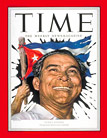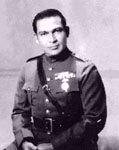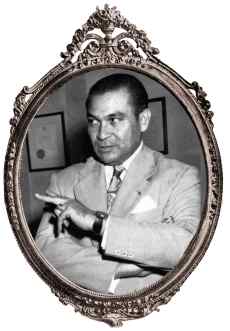
Batista
by Jerry A. Sierra

THE COVER OF TIME MAGAZINE (April 9 1952) showed a photo of Batista with a Cuban flag behind him, and the caption: "Cuba's Batista: he got past Democracy's sentries." Ironically, that was not the first time that Batista had bypassed the process of Democracy, with the full blessing and encouragement of its self-appointed guardians. Twenty years earlier Batista had become the strongman that would come to symbolize the heart and soul of Roosevelt's "Good Neighbor Policy."
Ruben Fulgencio Batista Zaldívar was born in Cuba's Oriente Province on January 16 1901. His parents, who lived and worked in a sugar plantation, were said to be of mixed race; Negro, white, Indian, and (it was popularly believed) Chinese. In 1921 he joined the army as a private, and in 1932 he became a military tribunal stenographer with the rank of sergeant.
The First Coup

In an uprising known as the "Revolt of the Sergeants," Batista took over the Cuban government on September 4, 1933. The coup overthrew the liberal government of Gerardo Machado, and marked the beginning of the army's influence as an organized force in the running of the government. It also signaled Batista's emergence as self-appointed chief of the armed forces, king-maker and favored U.S. strong man.
U.S. Ambassador Benjamin Sumner Welles, sent to Cuba in April of 1933 to mediate differences between the government and opposing political groups, found an ally in Batista. "You're the only individual in Cuba today who represents authority," he said to the recently self-appointed Chief of the Military. When Batista asked what the U.S. "wanted done for recognition," Welles replied, "I will lay down no specific terms; the matter of your government is a Cuban matter and it is for you to decide what you will do about it." To Batista, this was an invitation to rule.
On January 14 1934, Batista forced provisional president Ramón Grau San Martín to resign, and he appointed Carlos Mendieta to the presidency. Within five days, the U.S. recognized Cuba's new government.
For the next decade Batista ran the country from the background, using puppet presidents [Carlos Mendieta (1934-35), José A. Barnet (1935-36), Miguel Mariano Gómez (1936) and Federuco Laredo Brú (1936-40)] and having his way with the government, which continued a thirty-year tradition of corruption.
Batista was well liked by American interests, who feared Grau's liberal social and economic revolution and saw him as a stabilizing force with respect for American interests. It was in this time period that Batista formed a renowned friendship and business relationship with gangster Meyer Lansky that lasted over three decades.
Through Lansky, the mafia knew they had a friend in Cuba. Gangster Lucky Luciano, after being deported to Italy in 1946, went to Havana with a false passport. A summit at Havana's Hotel Nacional, with mobsters such as Frank Costello, Vito Genovese, Santo Trafficante Jr., Moe Dalitz and others, confirmed Luciano's authority over the U.S. mob, and coincided with Frank Sinatra's singing debut in Havana. It was here that Lansky gave permission to kill Bugsy Siegel for skimming construction money from the Flamingo in Las Vegas.
Many of Batista's enemies faced the same fate as the ambitious Siegel. One of his most bitter opponents, Antonio Guiteras (founder of the student group Jóven Cuba) was gunned down by government forces in 1935 while waiting for a boat in Matanzas province. Others just seemed to disappear into thin air.
Batista's chance to sit on the president's chair came in 1940. Supported by a coalition of political parties, and by the Communists, he defeated his old rival Grau San Martín in the first presidential election under a new Cuban constitution. During his presidency, trade relations with the U.S. increased, and a series of war taxes were imposed on the Cuban population. In 1944, Grau San Martín was elected president and Batista was forced to relinquish control.
While living luxuriously in Daytona Beach, Florida, Batista ran for and won a seat in the Cuban Senate in 1948. Four years later he was running for president, but a poll published in the December, 1951 issue of the popular magazine "Bohemia" showed him in last place.
The Second Coup

On March 10 1952, almost twenty years after the Revolt of the Sergeants, Batista took over the government once more, this time against elected Cuban president Carlos Prío Socorras. The coup took place three months before the upcoming elections that he was sure to lose. Also running in that election (for a different office) was a young, energetic lawyer named Fidel Castro. On March 27 Batista's government was formally recognized by U.S. President Dwight D. Eisenhower.
Shortly after this recognition, Batista declared that, although he was completely loyal to Cuba's constitution of 1940, constitutional guarantees would have to be temporarily suspended, as well as the right to strike. In April, writes Hugh Thomas in The Cuban Revolution, "Batista proclaimed a new constitutional code of 275 articles, claiming that the 'democratic and progressive essence' of the 1940 Constitution was preserved in the new law."
Batista opened the way for large-scale gambling in Havana, and he reorganized the Cuban state so that he and his political appointees could harvest the nation's riches. He announced that his government would match, dollar for dollar, any hotel investment over $1 million, which would include a casino license, and Lansky became the center of the entire Cuban gambling operation.
Under Batista, Cuba became profitable for American business and organized crime. Havana became the "Latin Las Vegas," a playground of choice for wealthy gamblers, and very little was said about democracy, or the rights of the average Cuban. Opposition was swiftly and violently crushed, and many began to fear the new government.
Just over a year after Batista's second coup, a small group of revolutionaries led by Fidel Castro attacked the Moncada Army Barracks in Santiago on July 26, 1953. The attack failed, and Batista sent General Martin Tamayo, the military commander of the district, a note ordering him to "kill ten rebels for every soldier killed" in the attack. This Presidential order was quickly dubbed the "ten-for-one" law. Tamayo carried out his order, murdering fifty-nine additional rebels (it would have taken 190 deaths to fulfill Batista's request).
Having easily defeated the rebellion, and with Castro and most of the others in jail or dead, business was back to normal in Cuba. Mafia boss Meyer Lansky turned Havana into an international drug port, and Cuban officials continued to get rich even after a few years in government. Nightly, the "bagman" for Batista's wife collected 10 percent of the profits at Trafficante's casinos; the Sans Souci, and the casinos in the hotels Sevilla-Biltmore, Commodoro, Deauville and Capri. Batista's take from the Lansky casinos, the Hotel Nacional, the Montmartre Club and others, is said to be 30 percent. That was aside from his fair share of Cuba's general funds that should have been going to education, public health and city maintenance.
For a price, Batista handed contracts to dozens of U.S. corporations for massive construction projects, such as the Havana-Varadero highway, the Rancho Boyeros airport, train lines, the power company and a strange plan to dig a canal across Cuba.
Due to popular unrest, and to appease his U.S. friends, Batista held a mock election in which he was the only legal candidate. He won, becoming president of Cuba in 1954. Cubans, however, had learned not to trust him, and were demanding new, legitimate elections.
The distinguished Colonel Cosme de la Torriente, a surviving veteran of the Cuban War of Independence, emerged in late 1955 to offer compromise. A series of meetings led by de la Torriente became known as "El Diálago Cívico" (the civic dialogue). Writes Hugh Thomas: "This Diálago Cívico represented what turned out to be the last hope for Cuban middle-class democracy, but Batista was far too strong and entrenched in his position to make any concessions."
Batista was so confident of his power that on May 15, 1955, he released Castro and the remaining survivors of the Moncada attack, hoping to dissuade some of his critics. Within weeks it was rumored that Batista's military police was looking to kill Castro, so the rebel went to Mexico to plan the revolution.
The Havana Post, expressing the attitude of the U.S. business community after a survey of the four years of Batista's second reign, alluded to the disappearance of gangsterism and said: 'All in all, the Batista regime has much to commend it." Hugh Thomas disagrees with that commentary. "In a way," Thomas writes, "Batista's golpe formalized gangsterism: the machine gun in the big car became the symbol not only of settling scores but of an approaching change of government."
By late 1955 student riots and anti-Batista demonstration had become frequent. These were dealt with in the violent manner his military police had come to represent. Students attempting to march from the University of Havana were stopped and beaten by the police, and student leader José A. Echeverría had to be hospitalized. Another popular student leader was killed on December 10, leading to a funeral that became a gigantic political protest with a 5-minute nationwide work stoppage.
Instead of loosening his grip, Batista suspended constitutional guarantees and established tighter censorship of the media. His military police would patrol the streets and pick up anyone suspected of insurrection. By the end of 1955 they had grown more prone to violent acts of brutality and torture, with no fear of legal repercussions.
In March of 1956 Batista refused to consider a proposal calling for elections by the end of the year. He was confident that he could defeat any revolutionary attempt from the many factions who opposed him.
Batista continued to rule with his usually confident iron fist, even after the landing of the Granma in December of 1956 (which brought the Castro brothers back to Cuba along with Che Guevara and marked the beginning of the armed conflict).
Due to their continued opposition of the dictator, the University of Havana was temporarily closed on November 30 1956. (It would not re-open until early 1959, after a revolutionary victory.) But that did not end the flow of student blood, including Echeverría's, who was killed by police after a radio broadcast on March 13 1957.
Batista's police also tracked down and killed Frank País, a coordinator with the 26th of July Movement, inciting a spontaneous strike in the three easternmost provinces of Cuba.
That same year, in midst of the revolutionary upheaval, the 21-story, 383-room Hotel Riviera was built in Havana at a cost of $14 million, most of which came from the Cuban government. It was Lansky's dream and crowing achievement. The hotel opened on December 10, with a floor show headlined by Ginger Rogers. Lansky's official title was "kitchen director," but he controlled every aspect of the hotel. He complained that Rogers "can wiggle her ass, but she can't sing a goddam note!"
But the seeds of the revolution had already sprouted a stronger, determined movement that would not allow the future of the Cuban nation to remain in the hands of gangsters and corrupt politicians.
Another fake election in 1958 placed one last Batista puppet in the president's chair, but loosing the support of the U.S. government meant his days in power were numbered.
On January 1, 1959, after formally resigning his position in Cuba's government and going through what historian Hugh Thomas describes as "a charade of handing over power" to his representatives, remaining family and closest associates boarded a plane at 3 a.m. at Camp Colombia and flew to Ciudad Trujillo in the Dominican Republic.
Throughout the night various flights out of Camp Colombia took Batista's friends and high officials to Miami, New York, New Orleans and Jacksonville. Batista's brother "Panchín," governor of Havana, left several hours later, and Meyer Lansky, suffering from ill health, also flew out that night. There was no provision made for the thousands of other Cubans who had worked with Batista's regime.
Batista died on August 6 1973, in Estoril, Portugal.
-end-
Return to 1933
The War Against Batista:
Frank País |
Moncada |
The Granma |
Sierra Maestra |
References
|
Cuba
or the Pursuit of Freedom Cuba
and the United States: A Chronological History Cuba:
From Columbus to Castro and Beyond The Cuban Story |
Revolution
in Cuba: An Essay in Understanding Fidel
Castro's Political Strategy: Revolutionary
Cuba Roosevelt
and Batista |